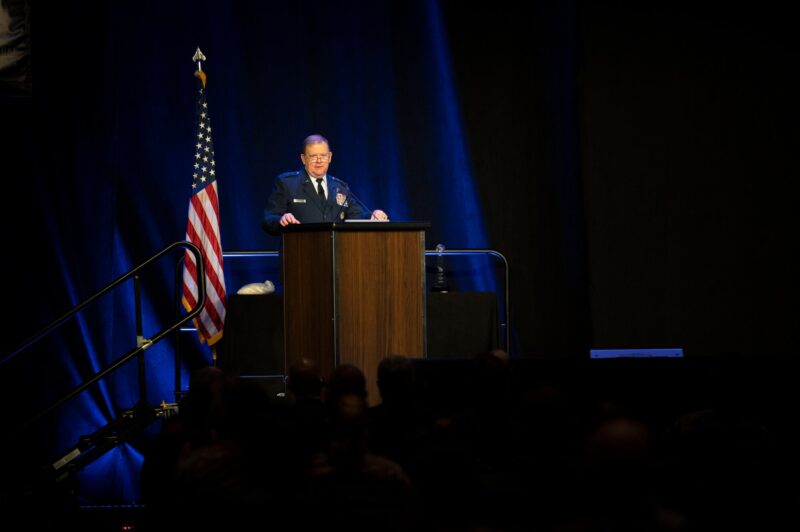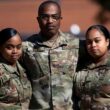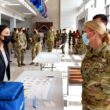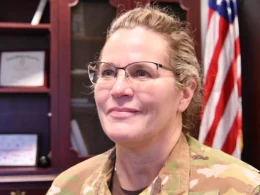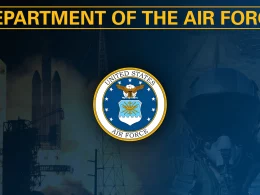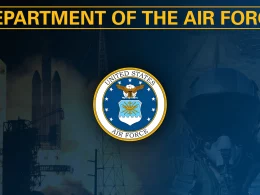ROBINS AIR FORCE BASE, Ga. —
Lt. Gen. Richard Scobee focused on three facets of the Air Force Reserve legacy during his keynote speech at the 53rd Airlift/Tanker Association Annual Convention, Symposium and Technology Exposition today in Orlando, Florida.
The three themes Scobee, chief of the Air Force Reserve and commander of the Air Force Reserve Command, discussed in the speech were the legacy being handed off to the next generation of Airmen, how that legacy was forged and the road ahead in building on the legacy.
The slogan for this year’s event is Air Mobility: Leveraging Our Legacy To Aggressively Forge Our Future.
Scobee said the Air Force Reserve has, throughout its almost 74 year history, leveraged its legacy to forge its future. He said they have learned lessons from their history in order to continuously develop a force that is accessible, cost-effective, and experienced.
The Air Force Reserve has 12 core functions with rapid mobility being the second largest behind agile combat support. He said approximately 25% of all Air Mobility personnel are Reservists.
He went on to comment on the more recent examples of excellent total force displays noting that Reserve Citizen Airmen from medical, logistics, security forces, finance, and maintenance career fields met mission needs during Operation Allies Refuge. Airmen from nearly every career field work in remote locations, helping to manage temporary housing for evacuees as they get resettled.
The Air Force Reserve tries to deliver capability at speed of need. Scobee said within the first 24 hours of Operation Allies Refuge, the AFR generated 13 ready aircrews to assist with the evacuation.
Within 72 hours, the number had grown to 80 crews and 36 aircraft. In August alone, he said they supported 37 evacuation missions out of Kabul.
During Operation Allies Refuge, the world saw just how integrated and effective the Air Force total team is.
“You delivered our most vulnerable allies from danger, and in doing so delivered a message to the world about our resolve to honor our commitments as a Nation,” Scobee said. “Among those most vulnerable, was an expectant mother who gave birth in transit and named her daughter after the aircraft’s callsign: Reach. Reach’s mother couldn’t tell if the crewmembers delivering her child were Active Duty, Reserve, Guard, or part of an integrated team. All she knew was that she was in good hands.”
The Air Force Reserve is currently responsible for 62% of the Air Force’s aeromedical evacuation manning and 46% of the aerial port capacity. He said that more than half of our airlift capacity is in the reserve component. By that math, he said, without an accessible reserve component, the mission fails.
He cited the example of aerial port units saying they have the capacity to operate 16 small, nine medium and 11 large aerial ports. Yet they only have 124 full-time personnel to conduct the everyday business for 5,152 part-time Reserve Citizen Airmen. That math equals only one out of 40 Reserve aerial porters being full-time.
Sobee went on to laud the innovation of Staff. Sgt. Santosh Devkota and his work on the GATES software solution.
“That’s the beauty of the Air Force Reserve,” Scobee said. So many Reserve Citizen Airmen, by virtue of having a civilian career, are already multifunctional Airmen.”
He went on to discuss the three unique missions the AFR offers starting with the Hurricane Hunters weather reconnaissance mission out of the 403rd Wing on Keesler Air Force Base in Mississippi and how unfortunately, they often fly a mission while also having to worry about their families safety.
Such was the case with Hurricane Ida when they evacuated to Texas to continue operations as Keesler was in the route of the storm
Next was the fixed wing aerial spray missions capabilities of the 910th Airlift Wing on Youngstown Air Reserve Station, Ohio. During local recovery efforts after Hurricanes Laura and Delta the 910th treated over one million acres of land providing effective large area mosquito control.
Last, but certainly not least, the aerial firefighting mission of the 302nd Airlift Wing, Peterson Space Force Base, Colorado. Due to the continued threat of wildfires, their mission has shifted from being a seasonal mission to one in which they respond year round.
“2021 was the second busiest fire season in the 48 year history of the Modular Airborne Firefighting System’s history,” Scobee said. “In August, all eight of our aerial firefighting aircraft were activated for the first time since 2012.”
He said at one point over the summer the AFR was operating at over 150% capacity to prevent an already terrible situation from getting worse.
“I talk about these things for two reasons,” Scobee said. “The first is because I’m exceptionally proud of how much we contribute to protecting Americans. Whether it’s an away game or on our home turf, we bring our best.
Second, I talk about these missions because they’re one of the most frequent and visible demonstrations of how we are both a cost effective and accessible force as the Air Force Reserve.”
Scobee went on to herald the bravery of the Airmen involved in the DADDY-05 mission in 2010 and Air Force Reserve Critical Care Airborne Trauma Team provided medical care for Army Sgt. Daniel Powers in 2007.
“We get to hand off a legacy where stories like these have happy endings because we have built a culture of professional airmanship that is the envy of every other air force in the world, both allied and adversary,” said Scobee.
He went on to say that the AFR can ensure the commitment of everyone in the organization through trust. He said when Devkota’s leadership was presented his solution they had a choice to veto or approve it.
“If they had vetoed it without considering its merits because of his rank or inexperience, then they would have done a disservice to our Air Force because we would have lost that chance to innovate,” said Scobee. “Thankfully, his leadership chose to take smart risks.”
He said that leaders need to have the emotional intelligence to hear that things are broken and to build trust aggressively to ensure that their Airmen know their voices are heard. Leaders must be approachable enough that Airmen can bring their ideas and critiques.
“We must continue to remind ourselves that there is nothing wrong with the Air Force that cannot be fixed by what is right with the Air Force,” Scobee said. “This is how we, as a generation of Airmen, leverage our legacy to aggressively forge the future.”




